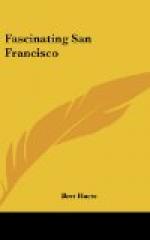From these cliffs is spread a vista of coast line and ocean with a sweep that extends as far north as Point Arena and as far west as the Farallon Islands, rugged points of rock reaching out of the ocean depths twenty-three miles off shore, and as far south as the azure thrust of Point Pedro.
Drifting along the cliff highway, which runs back of the fortifications that defend the port of San Francisco, you drop down past the dirigible hangar of the United States Army Flying Corps. You rise through Sea Cliff, a residence section like a hanging garden over the ocean, and come to Lincoln Park, where the flagstaff that marks the terminus of the Lincoln Highway, the end of a transcontinental trail, is set.
Following now a detour through city streets, instead of the highway that will soon traverse the cliffs, to the Cliff House, a resort foremost in the written and pictured annals of San Francisco, you glimpse three miles of sandy beach stretching southward to the jutting headlands of Point Pedro and you drop down to the boulevard that flanks the Esplanade, which the city is building as part of its playground plan.
Here is San Francisco’s Little Coney Island, where the multitude comes on Sundays by motor car and trolley, with lunch baskets and children, to frolic or rest on the sands that front the sea.
Gay booths and kiosks skirt the Esplanade, where vendors are kept busy supplying their wares and where everyone appears as carefree as the gulls wheeling above the white breakers.
As you continue south along the beach you pass the chalet of the Olympic Club, whose members sally forth on New Year’s Day for their dip in the surf. Presently you reach the Great Highway, which traverses the dykes of sand raised by wind and water as barriers against the ocean. Ahead of you are Sloat Boulevard and the Skyline Boulevard, which, skirting Lake Merced, stretches south through the shore mountains, its objective Santa Cruz, on the blue bay of Monterey.
This expanse of three miles of glistening sandy beach is a playground where the people may watch the ever-shifting panorama of sea and sky and hills. Seals can be seen sunning themselves on the rocks. Beyond them, riding the swells, are fishing boats, and still farther out cargo carriers and passenger liners make for distant points or come seeking haven in the Port of Adventure—San Francisco.
Clubs
Club life in San Francisco has won the admiration of many men of letters and other visitors. Kipling says appreciative things about the Bohemian Club in his American Notes that exceed anything written by its own historians. Julian Street, in his Abroad at Home, says that with her hills San Francisco is Rome; with her harbor she is Naples; with her hotels she is New York.
“But with her clubs and her people she is San Francisco, which to my mind comes near being the apotheosis of praise,” he adds.




